

FIRED


Midway through his fourth year, football head coach Brian Kelly is out.
SO LONG, KELLY
Embarrassing loss prompts firing of head football coach
BY ROSS ABBOUD Staff Writer
LSU football has officially fired head coach Brian Kelly, the school confirmed Sunday.
LSU’s administration and university executives held meetings to discuss head coach Kelly’s future at LSU throughout Sunday, according to multiple reports. The meetings also reportedly included Louisiana Gov. Jeff Landry.
On3 also reported that all of LSU’s position coaches who showed up at the facility Sunday were sent home amidst the con-
versation with officials.
Multiple outlets reported that a team meeting occurred 8 p.m. Sunday and lasted for about 10 minutes while Kelly addressed the team.
Kelly’s contract says he’s owed a buyout of about $54 million to be paid out monthly until 2031, though the price could be reduced if Kelly obtains other “football-related employment,” including in media or as a coach elsewhere.
However, the official buyout terms are still unsettled. LSU officials are working to negotiate with Kelly on a reduced number,
multiple outlets have reported. Ross Dellenger of On3 said the negotiation could take weeks or months.
Running backs coach and associate head coach Frank Wilson will be named the interim head coach. Wilson held the same interim position after former coach Ed Orgeron was fired in 2022.
The fate of the rest of the coaching staff is unclear.
Kelly was 34-14 overall and 19-10 in SEC play across his four seasons at LSU. He was 5-11 against opponents ranked in the nation’s top 25.
The team went 10-4 and played for the SEC Championship in his first season, while quarterback Jayden Daniels led a Heisman campaign in Kelly’s second year.
His teams qualified for and won three bowl games but never were selected for the College Football Playoff.
LSU lost to Texas A&M in embarrassing fashion Saturday, falling in Tiger Stadium by a score of 49-25. The team is now entering its bye week, and its next game is on Nov. 8 at Alabama.
Kelly was previously Notre Dame’s head coach for 12 years.
11
LSU crumbles in second half against Texas A&M
BY AINSLEY FLOOD Deputy Sports Editor
On paper, this should not have been a game that LSU won, but Death Valley was alive with belief as its home team entered the second half with the lead over Texas A&M.
It was the No. 20 team up against No. 3 and the SEC’s current top dog.
The Tigers already had two losses, one to Ole Miss and last week against Vanderbilt. Texas A&M was 7-0.
And yet, LSU led at halftime by three points.
However, the team eventually crumbled in the third quarter, allowing three touchdowns in that frame alone and ultimately falling 49-25.
“No one is more disappointed than our football team,” head coach Brian Kelly said. “They are looking for answers, and I have to be able to provide that for them. The performance in the second half was the most disappointing part of this game.”
At Vanderbilt, LSU’s defense couldn’t keep up with quarterback Diego Pavia, but it was the offense that once again dug the hole. Quarterback Garrett Nussmeier couldn’t hit his targets with a 68% completion rate, and the offensive line deteriorated throughout the game.
After poor performances on both sides of the ball, it was going to take a complete 180 to challenge the undefeated Aggies.
Under the bright lights of Tiger Stadium on Saturday night, the defense took the field first. Its coverage looked solid during the first drive, until it wasn’t.
Just like what happened at Vanderbilt and even last year at College Station, the Tigers were caught off guard by a running QB.
It was a tale as old as time for LSU fans. As soon as Texas A&M’s Marcel Reed really started
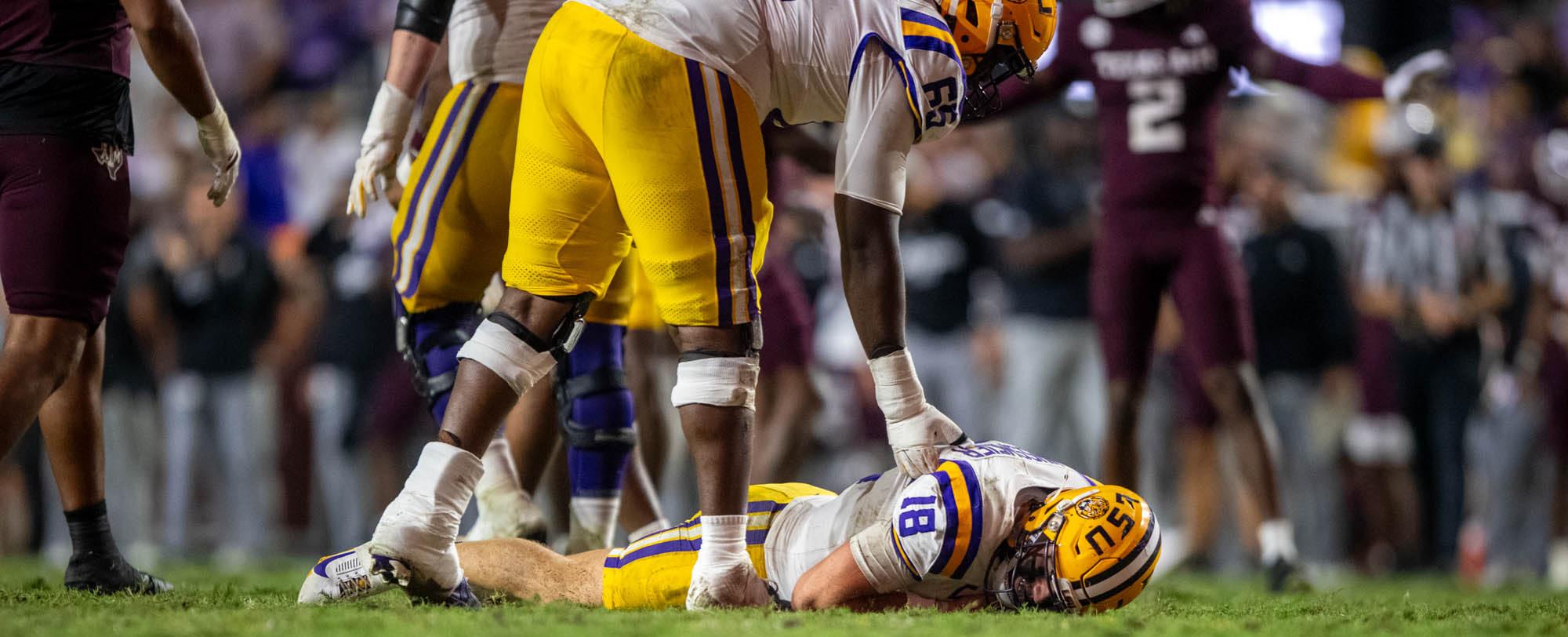
to use his legs, he was long gone. Not even five minutes into the first quarter, he ran 41 yards and into the end zone.
Reed had a night to remember, passing for 202 yards and adding 102 yards and two touchdowns on the ground.
LSU’s defense has had a noticeable decline in performance, especially with star linebacker Whit Weeks injured.
Rarely have the Tigers been able to answer almost immediately when down, but when LSU got to the 10-yard line on a pass interference call, Trey’Dez Green pushed them within five yards of scoring.
On the next play, Nussmeier took a risk: a pass to Green again, who was headed directly into the thick of a very crowded end zone. The pass connected, giving LSU the bounce back it needed.
On the following drive, first down after first down was allowed on the opposite side of the ball. The Aggies crept all the way to the 7-yard line, where Reed made a cut to the right and found an open receiver in the dead center of the end zone.
Down seven, the Tigers came back stronger in the second
quarter. PJ Woodland broke up a pass for a third down, and Jimari Butler hurried Reed to force an incomplete pass.
The Aggies chose to punt from the 5. Unexpectedly, safety Jhase Thomas dove and blocked the kick, sending the stadium into a frenzy. The ball tumbled out of the end zone for a safety and a much-needed two points.
The offense’s drive wasn’t as productive. Nussmeier went three-and-out after missing a wide-open Green in scoring position.
On third-and-3, Reed threw a bomb into the end zone, but didn’t anticipate AJ Haulcy cutting in from the right, sweeping in with an interception and going down at the LSU 25.
One of Nussmeier’s better moments was a 42-yarder to Barion Brown on third down, finally connecting a deep pass. Running back Harlem Berry got the first down with a rush up the center.
Berry was a standout in the first half with 56 rushing yards, averaging seven per carry, and a touchdown. But just like the majority of the offense, he became stagnant, with only a single carry for three yards in the second half.


B-16 Hodges Hall
Damian Ramos missed the extra point, but later kicked a 33yard field goal after the offense failed to convert a third down at the end of the half. LSU led 1814 by halftime, a staggering feat that gave Death Valley a pulse.
When both teams returned to the field, though, all that hard work proved fruitless.
An early drive saw Texas A&M average eight yards per play and reach the 4-yard line. Reed executed when it mattered and scrambled inside to put the team back in front.
That wasn’t even close to the end of it. After Nussmeier was sacked for the third time on the night, LSU punted, but it was returned all the way as Texas A&M’s KC Concepcion made a 79-yard mad dash for the end zone.
“Back-to-back touchdowns right out of the gates and then the inability offensively to get into rhythm hurt our team today,” Kelly said. “We did not play at the level that is needed to be successful. We struggled with protection, and we were not effective enough offensively to sustain any kind of rhythm.”
LOSS, page 11
Baton Rouge, La. 70803 LSUReveille.com

Louisiana State University
ADVERTISING (225) 578-6090
Layout/Ad Design ASHLEY KENNEDY
Layout/Ad Design REESE PELLEGRIN
CORRECTIONS
&
CLARIFICATIONS
The Reveille holds accuracy and objectivity at the highest priority and wants to reassure its readers the reporting and content of the paper meets these standards. This space is reserved to recognize and correct any mistakes that may have been printed in The Daily Reveille. If you would like something corrected or clarified, please contact the editor at (225) 578-4811 or email editor@lsu.edu.
ABOUT THE REVEILLE
The Reveille is written, edited and produced solely by students of Louisiana State University. The Reveille is an independent entity of the Office of Student Media within the Manship School of Mass Communication. A single issue of The Reveille is free from multiple sites on campus and about 25 sites off campus. To obtain additional copies, please visit the Office of Student Media in B-39 Hodges Hall or email studentmedia@ lsu.edu. The Reveille is published biweekly during the fall, spring and summer semesters, except during holidays and final exams. The Reveille is funded through LSU students’ payments of the Student Media fee.
HINESLEY BRYANT / The Reveille
LSU football fifth-year senior quarterback Garrett Nussmeier (18) lays on the ground after being sacked during their 49-25 loss against Texas A&M on Oct. 25 at Tiger Stadium in Baton Rouge, La.
DOWN TO SIX
Meet the potential candidates for the next president of LSU
BY LIV TEES Deputy News Editor
The LSU presidential search committee announced the names of the candidates whom they will formally ask to apply for the next president of LSU at the search meeting Thursday.
These candidates will go through interviews at the next meeting on Oct. 29 if they choose to apply. During that meeting, the committee will decide on the finalists to present to the Board of Supervisors who will then vote on the next president from the three finalists.
The candidates for LSU’s next president are:
Julius Fridriksson
Fridriksson is the current vice president of research and professor at the University of South Carolina in the Arnold School of Public Health. He has been at the university for over 24 years. His expertise is in brain health and memory functions.
Matt Lee
Lee is the current interim president for LSU. Lee has been a part of LSU for 21 years serving in positions such as vice president for agriculture and dean of agriculture, interim executive vice president and provost and senior associate vice president of research and economic development.

Robert Robbins
Robbins served as the president of the University of Arizona for seven years before retiring in 2024. He is currently a distinguished visiting fellow at Stanford University. He graduated with a bachelor’s in chemistry from Millsaps College and earned his doctorate in medicine from Ole Miss.
Wade Rousse Rousse has been the sitting president at McNeese University
since July 2024. He previously served as vice president for over a year and executive vice president for over two years at the University. He received his doctorate in economics from the University of Illinois at Chicago. He is also a professor of business and economics at McNeese.
Giovanni Piedimonte
Piedimonte has been a professor of pediatrics, biochemistry and molecular biology at Tulane University School of Medicine for over six years. He
previously held the position of vice president and institutional officer at Tulane.
President search nears end
BY MAIA TYLER Staff Writer
The presidential search committee narrowed down the pool of potential candidates for the next president Thursday, ultimately naming six it would ask to formally apply for the position.
The committee will publicly interview the selected candidates that choose to apply Wednesday before sending its recommendations to the LSU Board of Supervisors for the final vote.
Thursday’s meeting had a total of nine public comments spanning from members of LSU’s Students for a Democratic Society to two Boyd professors, a survey presentation with input from employees from each LSU campus and an executive session for the committee to discuss applicants.
Committee members Olivia Phelps and Daniel Tirone conducted a two-week survey to garner opinion from employees across all eight LSU campuses. In total, Phelps said over 1,350 LSU faculty and staff responded with input that outlined their hopes for the next president.
“The message that we received from faculty and staff was clear: that LSU’s greatest strength is our people, and the next president has to be someone who listens, builds trust and engages with our campus community,” Phelps said.
The candidates were assem-
The sixth candidate asked that their name and university of employment be confidential, according to SSA Consulting, the firm that assembled and vetted candidates on the search committee’s behalf. If they choose to apply, they must make their name public by Wednesday. The applicant’s current role is senior vice president for academic affairs and chief academic officer. see SEARCH, page 4
LSU reduces waste in annual game day recycling challenge
BY KALEY MELANCON Staff Writer
LSU students and organizations showed what it means to ‘Geaux Green’ on Sunday with post-gameday recycling efforts.
Every year LSU participates in the Game Day Recycling Challenge, a national competition between universities to reduce waste during one home football game. This year, it came down to the LSU-Texas A&M matchup.
The challenge is a Campus Race to Zero Waste program put on by the National Wildlife Federation. LSU Campus Sustainability Manager Lisa Mahoney said the goal is to promote a recycling culture for future game days.
“The easiest thing a user can do is to recycle,” Mahoney said.
On Friday, volunteers placed around 300 recycling bins across campus and tailgate areas.
Mahoney said bins were placed in the Touchtown Village parking lot, on the lawn of Patrick F. Taylor Hall and by the Vet School.
It all started at 4 a.m. Sunday — in the middle of a tornado watch — with students collecting the recycling bins around campus and in Tiger Stadium. After collecting the materials, they were dropped off at the bus depot on Gourrier Avenue to be sorted.
Under a pavilion, crawfish peeling tables and white folding tables were set up for sorting. Each table had gray square bins directly under them to catch the recyclables. White buckets were placed in the corner of the tables for students to drain any leftover liquid from the bottles.
The crawfish tables are wide, metal tables with six predrilled holes meant to discard crawfish shells. Here, they were used to
easily drop the bottles into the gray bins below. Four of the holes were used for aluminum cans while the other two were for plastic bottles.
At the end of all the tables, a normal trash can was placed for excess trash such as pizza boxes, chip bags or contaminated items like spit cups. Students grabbed a bag, dumped it onto the table and picked through each item to sort.
The sound of metal clanking together filled the air. As more bags arrived to be sorted, the students’ morale never appeared to waver.
Brook King, a member of Geaux Green, said she was there for her love of climate action and sustainability. She said it was fun to come out and that sorting the items was like playing a game.
King said being sustainable is all about mindfulness and
wanting to change. She said she goes to the football games with her dad so she knows she contributes to the trash problem.
“I think it is my responsibility to come and deal with the aftermath,” King said.
The sorting process is led by Osprey Initiative, which measures and counts the amount of items recycled. Osprey Regional Manager Trevor Besse said the organization creates an audit of the data to give more insight to the recycling efforts.
Osprey has also partnered with campus life to help reduce litter across campus.
Besse said last year it was able to determine that there was 47% recycled material compared to 53% waste from the items collected in the challenge bins. He said the data can tell LSU things such as what items to eliminate if the university wanted to reach zero waste.
“With it being student driven, students get to see how LSU is doing their part in sustainability,” Besse said.
LSU students were not the only students helping out. Albany High School basketball and baseball players were also there. Athletic Director Chris Beckham said Osprey makes a donation to the program for helping out.
Once a gray bin was full, volunteers poured it into dumpsters that were separated by plastic or aluminum. To keep count, Osprey Environmental Field Technician Sawyer Pendry kept a tally of every bin that was dumped. Pendry said she found out about Osprey through volunteering while at LSU. She said Osprey counts the amount of bottles in one bin and weighs it. Then, she said they repeat this for five different bins.
JASON WILLIS / The Reveille
FACULTY
CAMPUS LIFE
RECYCLE, from page 3
Pendry said they take the average of the five bins to apply for the rest of the bins tallied up. Within half an hour, 50 bins of aluminum cans and 20 bins of plastic bottles had already been counted.
The total amount collected by LSU will determine whether it wins the challenge in January. Mahoney said LSU won the challenge in 2016, 2017 and 2019 but has not done as well since the COVID-19 pandemic.
However, Mahoney said they are trying to get back in the
bled and vetted by SSA Consulting. The firm’s CEO Christel Slaughter said it compiled a list of 30 interested parties in the pool of presidential candidates. This list was broken down into four parts: the top five, a second tier of five, 20 other candidates and five applicants who will not be moving forward in this process with LSU.
One of the top candidates chose to remain anonymous. The candidate, who has a doctorate and experience as a senior vice president for academic affairs and a chief academic officer, was formally introduced to the committee as “Confidential #4769.”
Louisiana’s public records law makes some exceptions for
game with enhancements each year. She said the office received grants from Keep Louisiana Beautiful that allowed it to upgrade the recycle bins used.
The sorting is only a piece of the entire process. Afterwards, Besse said the collected aluminum goes to Novelis, a recycling and rolling mill in north Alabama. For the plastic, he said it is sent to Indorama Ventures to be remade back into plastic bottles or polyester material.
Along with aluminum and plastic, glass was also collected. Mahoney said the materials get sent to Glass Half Full, a local
certain employment-related information to protect applicant privacy before a job offer is made. Applicants for high-level positions at public universities, like a university president, can choose to withhold names, current employment, educational background and other identifying information.
Some board members were critical of these laws at the meeting, saying they made the process of finding qualified candidates more difficult.
“I hope that the media, and especially throughout the state government, take note of the gymnastics that you have to go through under the current state laws in open meetings to get to excellent candidates,” said Roger Ogden, a member of the LSU Foundation’s Board of Directors.
initiative in Louisiana that turns the glass into sand to be used for coastal restoration.
The impact on the environment is what is important to chemical engineering sophomore Lily Bradford. She said it felt good to see stuff being recycled and being part of it.
Bradford said she is super passionate about sustainability and tries to recycle in her dayto-day life. She said if everyone does their small part then it can make a huge difference. “We only have one Earth and we really need to take care of it,” Bradford said.
“It is not a current law that encourages greater inquiry for applications.”
During their hour-and20-minute executive session intermission, the committee privately discussed the candidates the committee would urge to move forward in the application process. Before this, the committee passed amendments to ensure the integrity of the applicants they want in their process.
The first was proposed by James Williams, who put forward the motion to exclude redacted individuals from moving further in the application process if they do not give their identity by the interview date.
Rémy Starns proposed the second amendment, which narrowed the list down to the following candidates: Julius Fridriks -
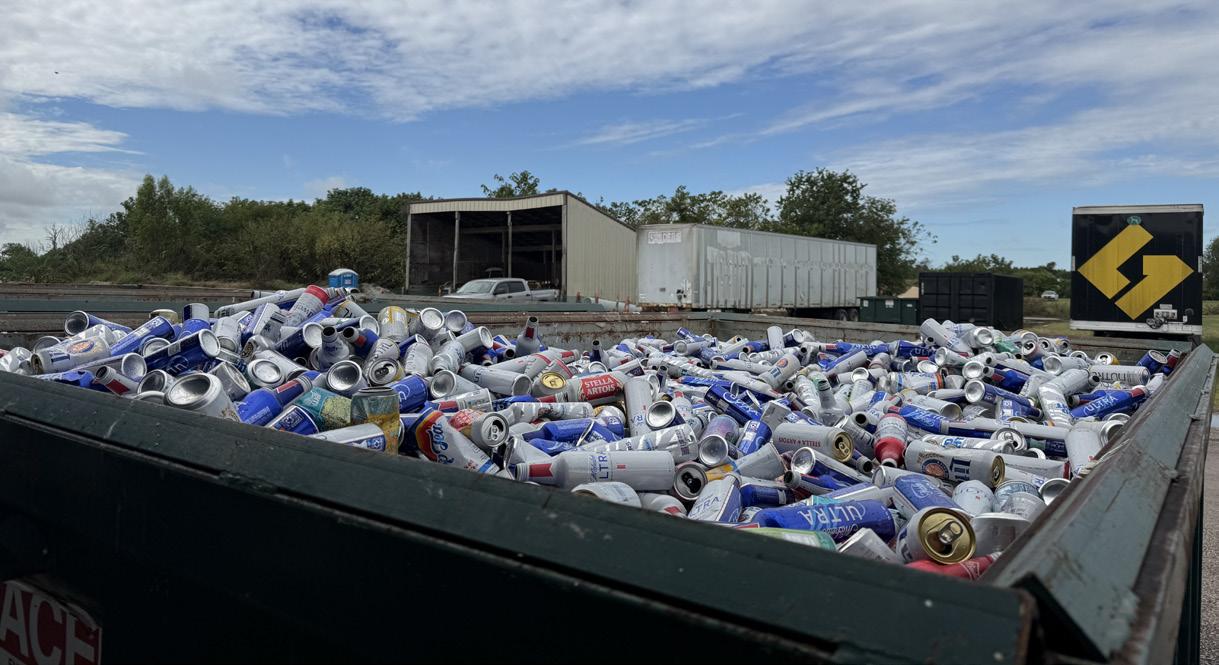
son, current Interim President Matt Lee, Robert Robbins, Wade Rousse, Giovanni Piedimonte and candidate #4769, if they reveal their identity to the public before the interview Wednesday.
The search committee will now hold public interviews with the candidates that choose to apply Wednesday starting at 9 a.m.
“We are inviting people to formally apply and be interviewed next week, and so whether they apply or not is up to them,” LSU Vice President of Legal Affairs and General Counsel Trey Jones said after the meeting.
In addition to the interviews, the committee also said it would meet with key LSU stakeholders including the Board of Supervisors, chancellors at the LSU system universities, Boyd Professors, faculty, students and donors. It is
unclear when these meetings will occur since the committee will make its top recommendations Wednesday, but it previously said they would occur between Wednesday and next Tuesday.
In addition to the interviews, the committee also said it would meet with key LSU stakeholders including the Board of Supervisors, chancellors at the LSU system universities, Boyd Professors, faculty, students and donors. It is unclear when these meetings will occur since the committee will make its top recommendations Wednesday, but it previously said they would occur between Wednesday and next Tuesday.After the committee recommends its finalists, the Board of Supervisors will hold a special session, yet to be scheduled, to vote on the university’s next president.
LSU unveils advanced microscrope for on-campus research
BY MADELYN LONG Staff Writer
On Thursday, LSU unveiled the most advanced microscope in the state-of-the-art Advanced Microscopy and Analytical Core facility.
Interim President Matt Lee, Vice President of Research and Economic Development Robert Twilley and Board of Supervisors Chair Scott Ballard attended the ceremony. There were live demonstrations and detailed presentations on the technology, emphasizing how LSU is becoming a leader in scientific discovery and innovation nationally.
The new microscope, the Spectra 300 Scanning Transmission Electron Microscope, called the S/TEM, enables LSU students and faculty to address issues related to national defense, energy security and technological innovation with advanced atomic imaging and analysis technology.
“This is the kind of investment that builds the future of Louisiana,” Lee said. “It strengthens our platform on which we can innovate. It provides a clear example for us on how Louisiana delivers on its promises. On how we lead in research and innovation, education and service.”
The S/TEM has the mag-
nification power of 10 million times, which is powerful enough to enlarge a single piece of river silt to the size of Tiger Stadium. This magnification power reveals material structure and chemistry, allowing for advancements in energy sources and supporting biomedical research. Lee described the microscope as more than a piece of equipment.
“We need to think of it as a catalyst for discovery, a catalyst for innovation, a catalyst for inspiration as we continue to explore the boundaries of human knowledge,” Lee said.
The preparation for LSU’s newest technological addition came long before this year.
Three years ago, professors addressed their need for a higher power microscope to the former Vice President of Research and Economic Development Sam Bentley. He took the opportunity to work with Louisiana Congressional members to write a budget proposal that would allow the U.S. Army $10 million to fund the project.
The proposal was successful, but it was the first of many steps in the process.
“There’s identifying the need, identifying the possible funding source, getting the funding, deciding what it is exactly you are going to buy, building the facility and installing the technol-
ogy,” Bentley said.
Specifically, the Advanced Microscopy and Analytical Core facility needed approximately $300,000 in renovations before the microscope could even be installed due to its 13-foot size and vibration weakness. But the time and funds spent became worth it when the microscope was available for use on campus.
Both the Interim President and Board chair expressed their deepest gratitude to the U.S. Army for their role in the advancement and the belief in LSU’s ability to take on such an important project.
“This moment reflects what happens when collaboration and purpose align,” Ballard said. “When higher education, federal partners and innovation come together to strengthen Louisiana’s role on the national stage.”
This new microscope sets the tone of LSU’s role in innovation for the future. Twilley said that talent and facilities attract the best of the best to LSU.
By offering unprecedented research capabilities, LSU is positioned to attract top-tier scholars, inspire students and drive discoveries that will benefit industries and communities throughout the state. He compared the idea to athletics, stating that research is no different.
In order to produce the winning team, it requires the best facilities to attract the best talent. The microscope is included in LSU’s first core research facility, and Twilley expresses that it will definitely not be the last.
Twilley said that the Advanced Microscopy and Analytical Core facility is “the first of more to come to attract, train and support the best research talent for Louisiana and build research teams that win.”

COURTESY OF EDDY PEREZ
Interim LSU President Matt Lee, Vice President of Research and Economic Development Robert Twilley, Student Body President and student member of the LSU Board of Supervisors Lavar Henderson, Supervisor Rebecca Boniol, and Board Chair Scott Ballard cut the ribbon in celebration of the launch of the new microscope.
KALEY MELANCON / The Reveille
Dumpster of recycled aluminum cans sit on LSU’s campus on Oct. 26 fllowing the LSU-Texas A&M matchup.
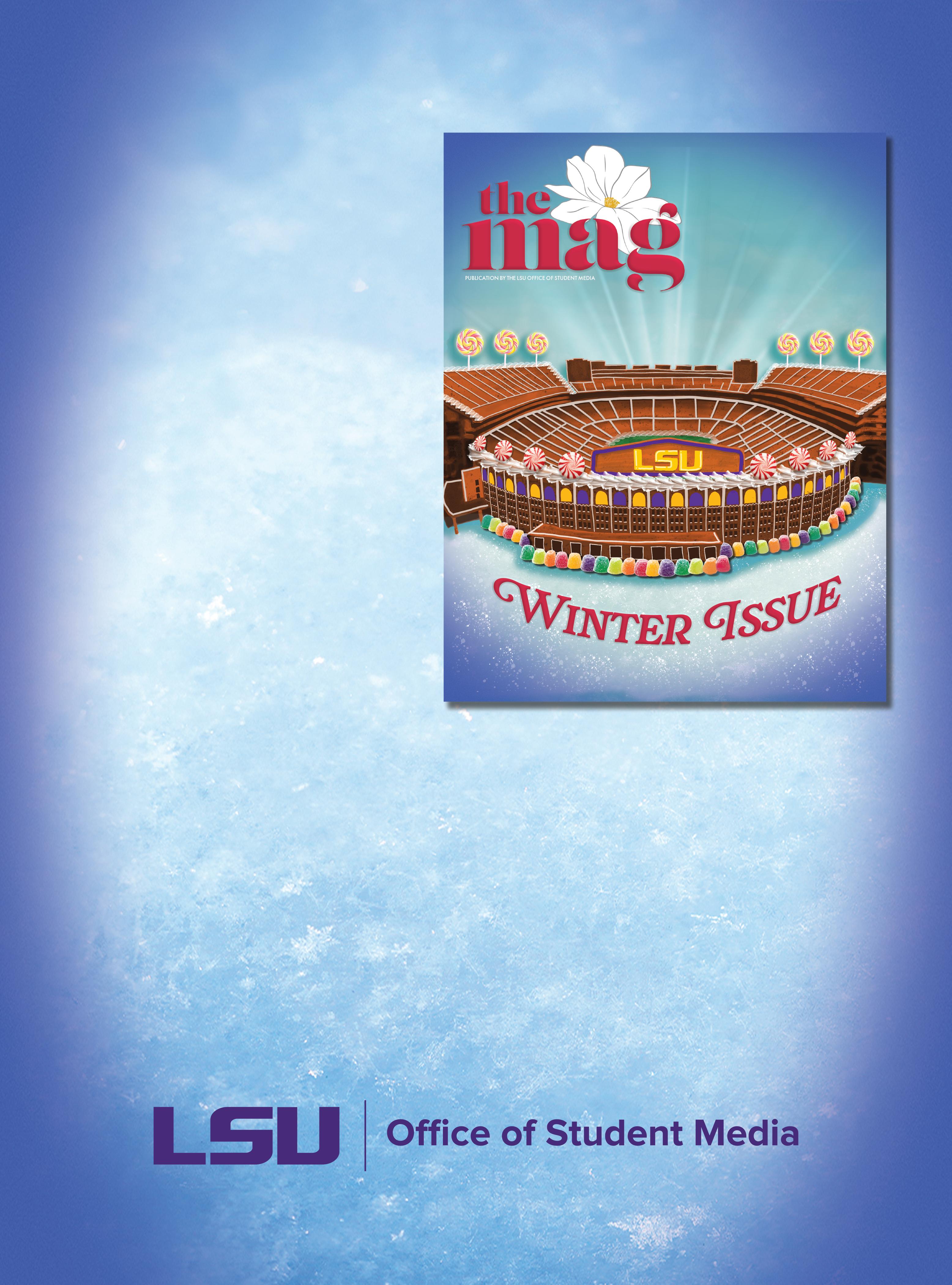





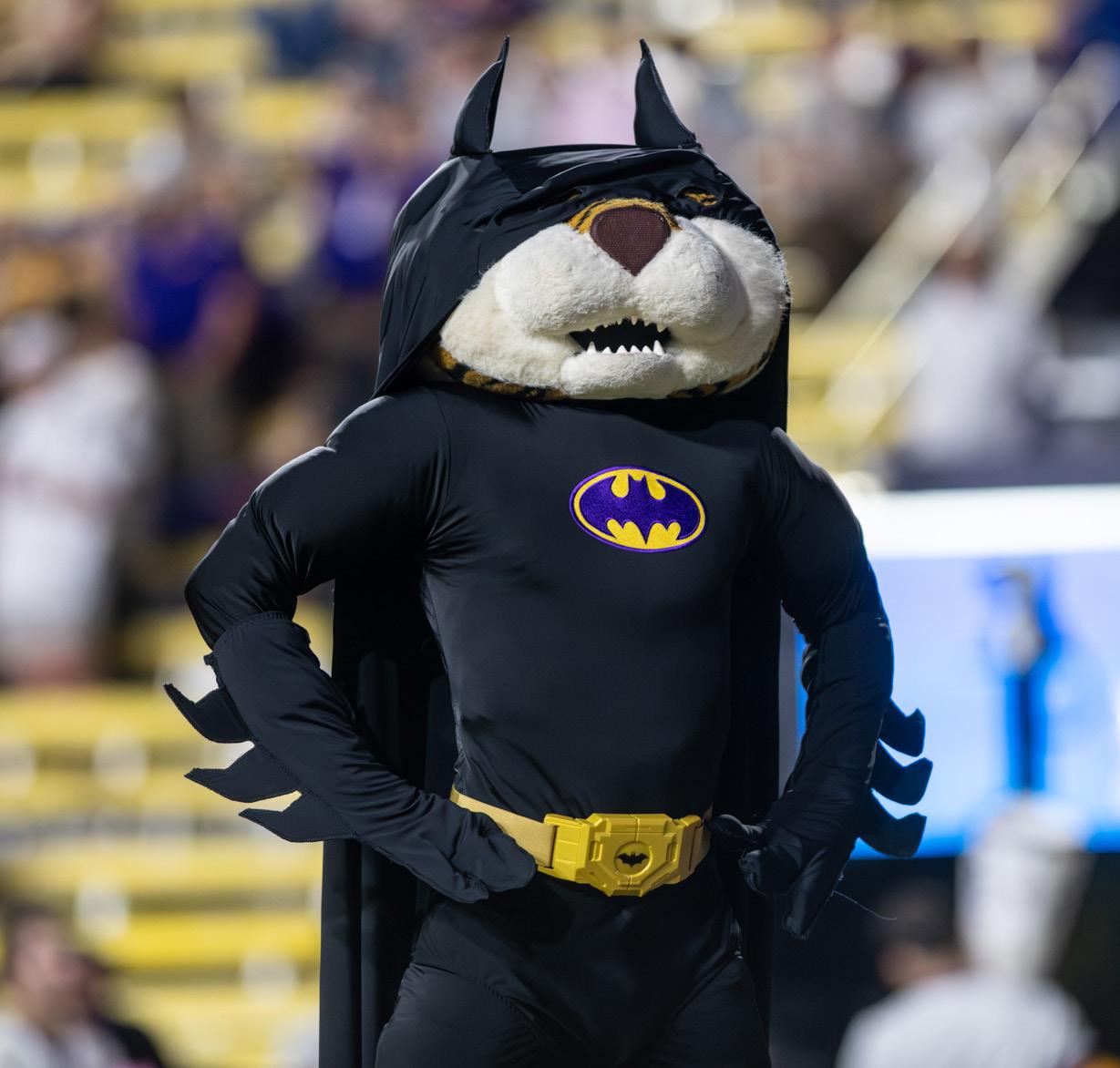
TIGERS DOWN
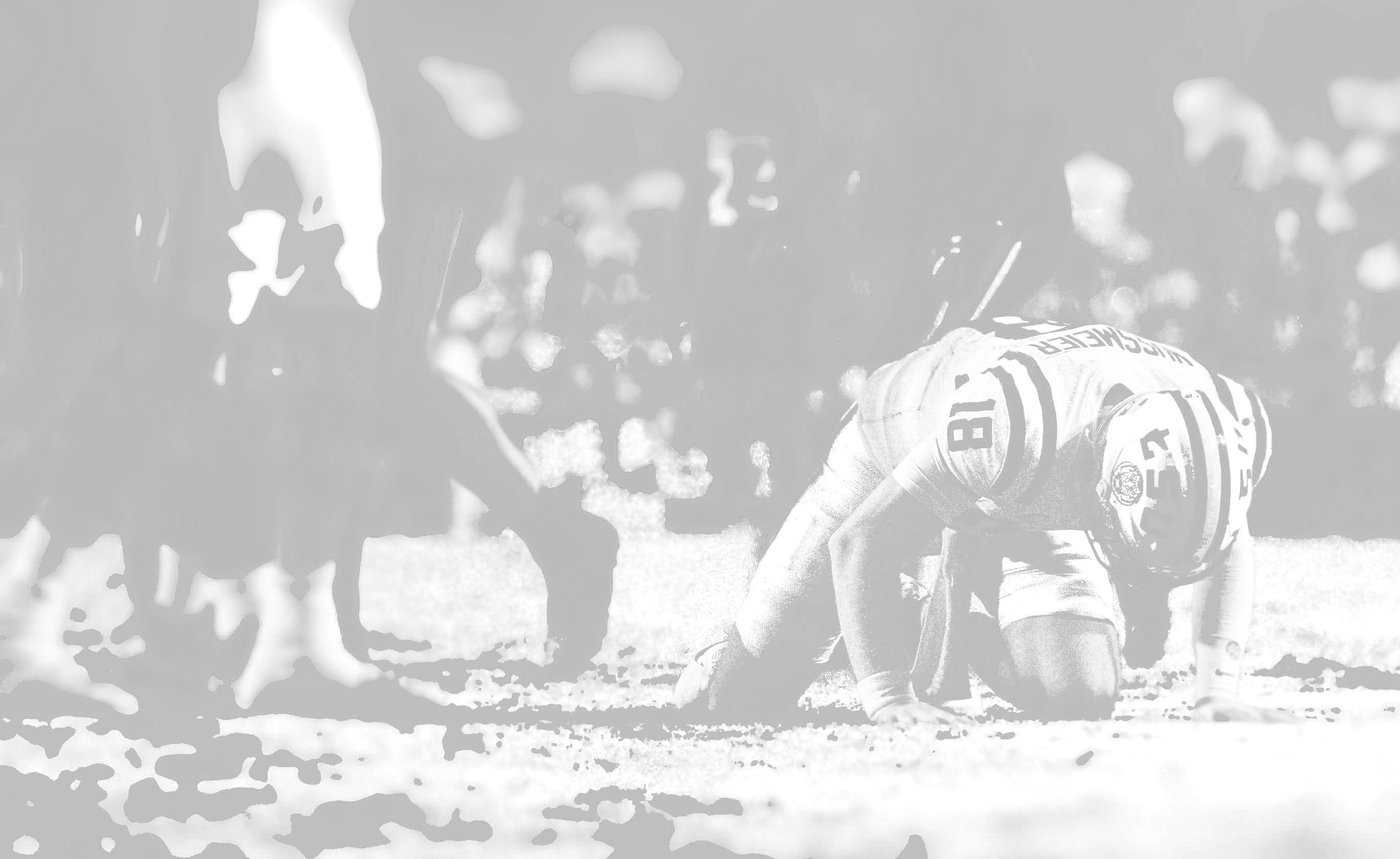
The Tigers fall to Texas A&M in a 49-25 loss on Oct. 25 at Tiger Stadium in Baton Rouge, La.
LSU football players huddle up during warmups.
LSU football graduate student defensive tackle Jimari Butler (12) tackles the receiver.
LSU tiger band freshmen trombone player Brennan Besse plays his music.
Mike the Tiger dresses up in a Batman costume.
LSU football sophomore quarterback Michael Van Buren Jr. (11) runs the ball.
LSU football fifth-year senior quarterback Garrett Nussmeier (18) lays on the ground hurt.
Photos by Hinesley Bryant | Design by Riley White
ENTERTAINMENT
Musical Theatre Club prepares for second show of year
BY LAURA ALLEN Staff Writer
“Falsettos” is an irreverent musical about the ups and downs of family life, assuring audiences that no matter what each day brings, everything will be alright.
LSU’s Musical Theatre Club is preparing for its second show of the season, “Falsettos,” written by William Finn and directed by recent LSU graduate Callie Ancelet. Set in the early 1980s, this musical comedy follows Marvin and his family as they navigate the messy complexities of love, acceptance and identity.
“‘Falsettos’ is a slice of life,” Ancelet said. “Really, really true life.”
This musical features a company cast, meaning the characters are not split into leads and ensemble but rather carry equal weight. Seven characters make up the unconventional family tree: Marvin, his lover Whizzer, his ex-wife Trina and his son Jason, as well as his psychiatrist Mendel and his two lesbian neighbors, Cordelia and Charlotte. This production has a main cast and an understudy cast.
The characters are all very
different, each one grappling with his or her own inner battles, but the well-roundedness of the whole cast brings a grounded sense of realness to the musical that audiences will undoubtedly relate to.
Ancelet said that many playwrights tend to present audiences with romanticized versions of real life, whereas “Falsettos” is unapologetically real, despite some of its absurdity.
“‘Falsettos’ is very raw,” Ancelet said. “It’s very matterof-fact, and you’ll see it in the lyrics of each song and the dialogue. It’s very nitty gritty, so be ready for sure. Brace yourself.”
One of the show’s main themes is queer identity. Four of the seven characters are in homosexual relationships, a change in pace from most broadway musicals, which usually spotlight hetersexual relationships.
Morgane Campbell, a sophomore psychology major, is proud to play the role of Cordelia, being a queer woman herself.
“I feel like it’s very few and far between to find lesbian characters who are so prideful about being lesbian,” Campbell said. “People in the audience are going to see queer people being
queer people, and I think that’s very important.”
“Falsettos” is a sung-through musical, meaning that the songs are back-to-back with no dialogue in between. These songs, in true 90s musical fashion, comprise fast-paced lyrics, complex rhythm and over-lapping vocal parts that make the soundtrack much more difficult to learn. However, the cast has put together an impressive show in just eight weeks of rehearsals.
The simplicity of the set allows the music and acting to shine. Black blocks are rearranged to create countless spaces, including a kitchen counter, a baseball stadium and a psychiatrist’s office. Because of the set’s minimalism, it is the actors’ performances that create the illusion of different environments.
Still what truly sells the production is the chemistry between the actors themselves. Within 30 seconds of sitting in on rehearsal, it was clear how close they have all become over the past month. Their witty banter, inside jokes and vulnerability with one another all translate to their on-stage performances, adding another layer of realness to the show.
Anthony Burton, a freshman vocal performance major, said the most rewarding part of his experience so far has been working with and getting to know his fellow castmates.
At the end of the day, “Falsettos” is more than a laugh-outloud comedy. It is the heartwarming story of a family learning to love and accept each other for who they are.
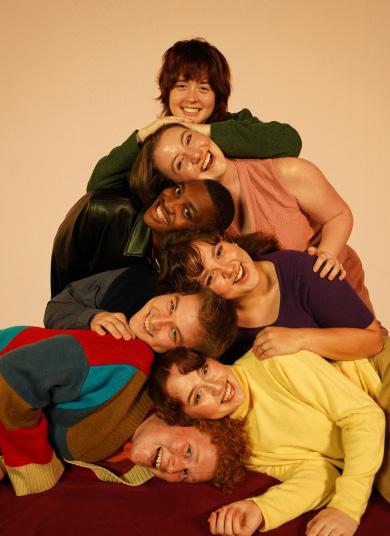
“You can’t choose how the people around you act or who they become,” Ancelet said. “You can only accept them and love them as they come.”
“Falsettos” opens next week in the Digital Media Center The -
atre, with shows on Oct. 30-31 and Nov. 1 at 7:30 p.m. and Nov. 2 at 2 p.m. Tickets are $10 for students and $15 for the public, and they can be purchased on the MTC’s website.
MDA organization stages assassin game, aiming for growth
BY SAVANNAH BOYNES Staff Writer
In strengthening community among students within the College of Music and Dramatic Arts, the University Theatre Alliance club presents the first Assassins game of the school year to encourage competitiveness and recreation amidst the chaos of post-midterm stress.
The UTA fosters student involvement through multiple mediums, such as book clubs,
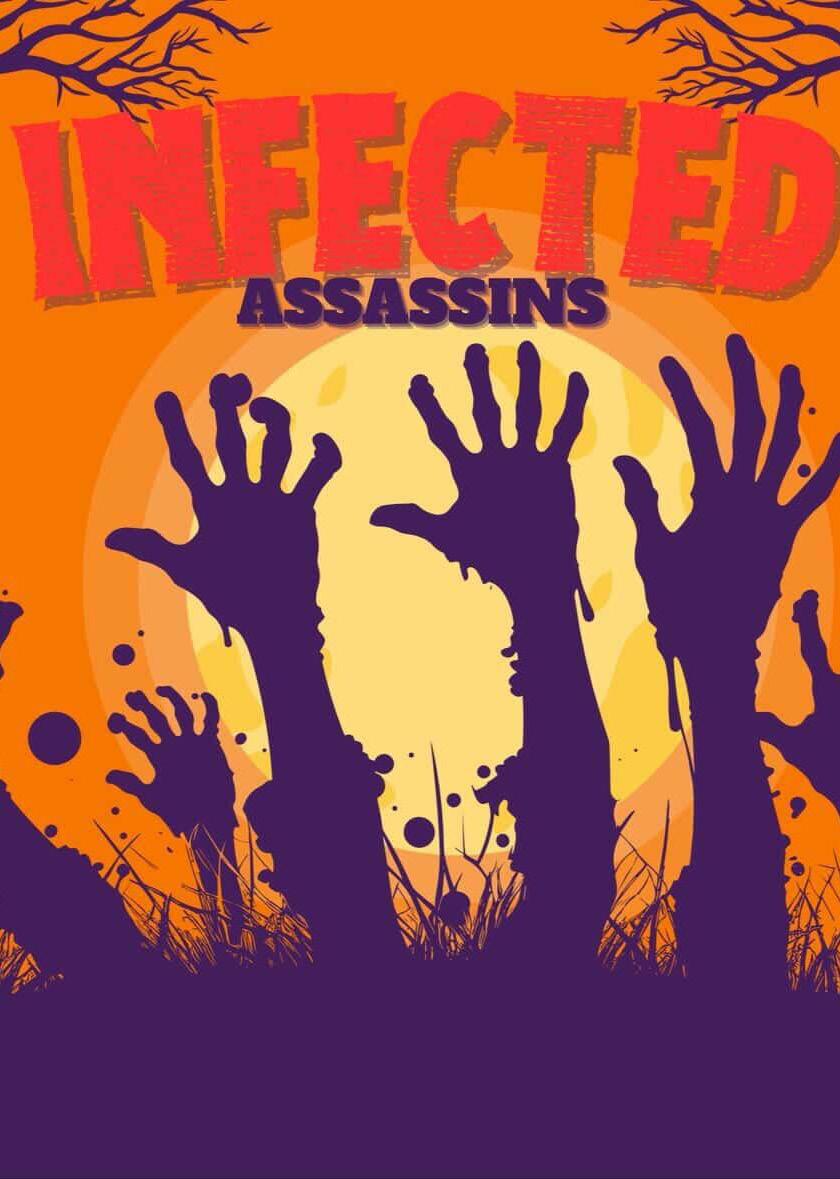
informational meetings and workshops. While the club does hold a focus on emboldening networking opportunities within these activities, it is also a chance for students to take a breath of fresh air from the stress of classes and their overall workload.
Junior theatre major and UTA President Hunter Sparacino said he started as an undergraduate student representative in the club before making his way up to the president position. He mentioned that Assassins used to be a club tradition years ago, and he decided to bring it back this past semester because of how it allows people from different artistic backgrounds to come together.
“Everything is so interconnected, yet we’re all so busy doing different things on a day-today basis,” Sparacino said. “To have a kind of event like Assassins where we’re all playing this kind of game together, I think it just gives a good general sense of community.”
Assassins is quite explanatory in its name; everyone is an assassin. Typically, all players start out with a water gun, and the game host tells each person who their target is. For as long as the game lasts, players must spend that time either watching their backs or hunting their
target. If a player manages to hit their target, they are given a new one to find; if one is hit with the water gun, they are eliminated.
To get even more attuned with the Halloween season, Sparacino placed an infectedlike twist on the typical Assassins game. Two players start out as the zombies, wearing a green bandana around their arm, and the remaining players are the survivors, adorning a red bandana instead. With this twist, no one is eliminated–rather, they just switch teams once infected.
Another new feature to the game will be the addition of a cure for any zombies, whether they are the original two or the slain survivors. The cure will be hidden around spots in the MDA building, and whichever team has the most players by the end of the week wins.
Sparacino goes even further to build community within the MDA space. By hosting games like Assassins and other engaging extracurricular activities, UTA allows for students to go beyond the more general and already offered ideas of the College of MDA, like improv or musical theater.
“We can make things happen in general. So overall, it’s important to me because it’s an outlet
for people to have fun and to do things that they want to do that aren’t available in other places,” said Sparacino. “And with that comes what I mentioned before, the kind of community building and just general unity that I would like to see in the MDA.”
Senior Ethan Hood, treasurer of the UTA, believes the club opens up opportunities to meet other members of the theatre community at LSU. This applies to Assassins as well, according to Hood.
Hood’s favorite part of UTA’s Assassins is being sneaky, because it is hard to do so in such a tight-knit community. He said that the cohabitation of everyone made it even more difficult to get the drop on people.
He believes that the UTA is also important for anyone who is just stepping into the theater space, and they don’t know where to start.
“I think theatre is a good medium to watch art and participate in it,” Hood said. “And so I say come to a book club meeting and see what you’re interested in.”
Hood is not alone in his belief that the UTA is a good introduction to theatre as a whole.
“UTA itself feels like the concept of it is acting as a central hub for sort of the whole community in a way, especially for
new people,” said Hunter Nastasi, senior arts administration major and secretary of UTA. “It feels like a really great way to introduce new people to the entire stratosphere of theatre.”
Nastasi participated in UTA’s Assassins this past semester, and he emphasized the intensity of the game. He explained how when stepping into the MDA building (the “danger zone”), he had to be on his toes; he would constantly look behind his back while also searching for his own target.
Despite the constant anxiety and having to watch his back every second, Nastasi said it was fun to have something to do in between classes. It gave him something to look forward to when coming to school, and the mystery of not knowing who to trust only added on to the excitement.
Nastasi said that games within the UTA, such as Assassins, promotes more people to hang out with each other, and it is a great way to start networking and for someone trying to become more known with the LSU theater circle.
Going beyond this great sense of community building, Nastasi wants people to know one more thing.
“I will win this year. I swear,” Nastasi said.
COURTESY OF LSU MUSICAL THEATRE CLUB.
A promotional photo for MTC’s “Falsettos.”
COURTESY OF HUNTER SPARACINO
A promotional poster for the Halloween edition of UTA’s Assassins game.
New Dutch Bros location opens just minutes from campus
BY MIA HATTAWAY Staff Writer
Baton Rouge is stirring up some excitement with the second Louisiana Dutch Bros Coffee now open off of West Lee Drive. The new location opened on Wednesday, Oct. 22 on 625 Frogmore Drive.
On Wednesday, Dutch Bros staff decorated customer’s cars with phrases such as “radiate kindness” and “Dutch Bros loves you.” Purple and gold streamers decorated the location, and much of the staff wore LSU gear.
Many customers reported that the line for opening day was wrapped around West Lee Drive to Burbank, to the point of causing traffic. One LSU student shared that it took about thirty minutes to order.
By Friday, it was clear that the hype hadn’t died down yet. Signage directed customers past Frog Alley to Bere Lane to move traffic off of West Lee. Once in line, it took around 10 minutes to order. After paying, it took about five minutes to get to the window and an additional four minutes to receive drinks.
Per Dutch Bros’ claim to fame, its customer service is energetic, competent and amiable. Though much of the staff is still training, their knowledge of the menu is plentiful and sure to help customers new to the company.
The Golden Eagle, one of the chain’s more popular lattes, is a smooth drink made of halfand-half, vanilla syrup, caramel syrup and caramel drizzle. For people that want a treat that won’t make their teeth ache, it is the perfect sip.
Dutch Bros Coffee is also known for its Blue Rebel energy drinks, which serve as the base for many signature menu items. The Shark Attack is a staple, with blue raspberry, coconut and lime syrups mixed into the Rebel, along with a pomegranate float, which is a concentrated flavor added on top of the drink. The Rebels are entirely customizable with over 25 flavors to mix and match.
For Tigers wanting to “espresso” their school spirit, order an energy with strawberry, blue raspberry and passionfruit soft top. The result is a refreshing drink that gradients from soft gold to deep purple. For a brighter purple, order a lavender fizz or a Dutch H20 with lavender and coconut milk.
Customers who download the app and make an account can get a free medium drink. Ordering ahead is not currently available for the Baton Rouge location, though it is expected to be added to the app soon.
Across the street from both CC’s Coffee and 7Brew, Dutch Bros is brewing up some serious rivalry.
CC’s Coffee is open daily from 6 a.m. to 8 p.m., while 7Brew operates from 5:30 a.m. to midnight Sunday through Thursday and 5:30 a.m. to 2 a.m. on Friday and Saturday. Dutch Bros is open from 5 a.m. to 10 p.m. Sunday through Thursday and 5 a.m. to 11 p.m. on Friday and Saturday.
Unless you’re up in the wee hours of the night, Burbank is sure to have you covered between these three options.
This Oregon-native chain is definitely shaking things up in Baton Rouge. For more information, visit the Dutch Bros website.

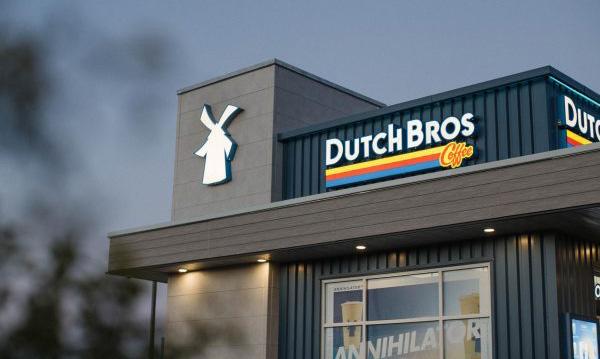

COURTESY OF DUTCH BROS COFFEE
SPORTS
Male cheerleader pursues nursing
BY DELANEY POTTHAST Staff Writer
Saturdays in Death Valley are all about adrenaline. The mix of gameday spirit, football and good company is what draws in many to be a part of the LSU family, and this was no different for one cheerleader.
Under the blinding stadium lights and the roar of over 100,000 fans, Kelvin Pickett channels that energy as one of the members of LSU’s coed cheer team, showcasing his strength and skill as he tosses flyers up in the air all night.
His heart doesn’t just stay in the stadium, however. When he’s not in uniform, Pickett is pursuing his journey to becoming an ICU nurse.
In the beginning, Pickett didn’t start cheerleading until his cousin suggested transitioning from gymnastics to fulltime tumbling. He was asked by friends to attend a practice for Prodigy All-Stars in the sixth grade, and Pickett’s cheerleading journey then took off at only age 11.
Though he started out on a prep-level team, Pickett made a large jump from Level 2 to Level 5, where he competed with Prodigy All-Stars Moonlight for two years during seventh and eighth grade.
“Moonlight kind of just got me in the rhythm of under-
see CHEER, page 11
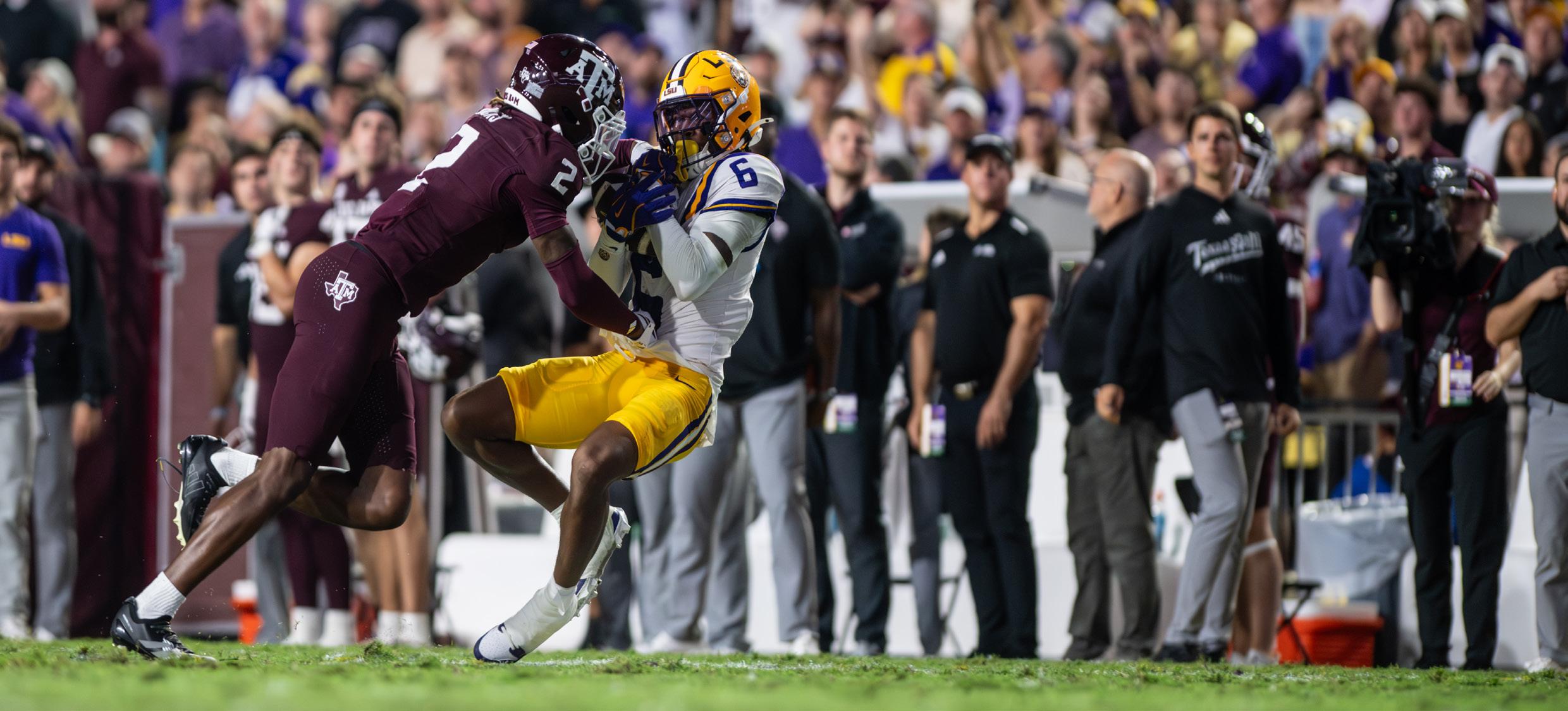
BY GABBY GRAY Staff Writer
Marching into Week 8 of the college football season with a 5-2 overall record, No. 20 LSU had something to prove in its humbling battle against No. 3 Texas A&M.
The Aggies traveled from College Station to Baton Rouge with an unfortunate history tied to them, given that they hadn’t won a game in Death Valley since 1994.
That 30-year-long losing streak changed Saturday night, as they slammed the Tigers in a 49-25 win.
Here are three takeaways from LSU’s loss to Texas A&M.
LSU’s offense still struggling to keep up
The words “Nussmeier, sacked!” were called out in Death Valley over and over again.
LSU quarterback Garrett
TAKE AWAYS 3
Nussmeier was sacked seven times, four of which were in the fourth quarter alone. The highest number of sacks taken in a game this season was previously three during LSU’s 23-7 victory over Louisiana Tech.
While the offensive line failed to protect its quarterback, there were still some opportune moments on its side during the first half of the game. Shortly after redshirt junior linebacker Harold Perkins Jr. secured an interception just before the end of the first half, the line paved the way for a 28-yard run from sophomore running back Caden Durham.
Overall, though, the sea of maroon and white drowned out LSU’s offense as LSU managed three touchdowns and 278 yards compared to six touchdowns and 426 yards by the end of the game for the Aggies.
The defense had its moments but was inconsistent
Whether it was failing to close pockets of space, which allowed Texas A&M quarterback Marcel Reed to run in the first touchdown of the game, or a lack of reaction time, LSU’s defense has certainly seen better nights.
The defensive highlights of the night were in the second quarter, with senior safety A.J. Haulcy’s interception of Texas A&M’s close touchdown and freshman safety Jhase Thomas’ impressive securing of a safety after blocking a punt.
While those bursts of energy were certainly something for Tiger fans to celebrate, they weren’t enough as the Aggies repeatedly drove through the defense, staining the night with a purple and gold loss.
If LSU wants to improve its defense, it’s going to have to maintain energy throughout its gameplay. Otherwise, it’ll be known as a defense with ‘good
moments,’ rather than a solid defense overall.
A.J. Haulcy stepped up for the defense
With star linebacker Whit Weeks out of the picture for now, someone on the defense had to step up against Texas A&M, and that someone was Haulcy. Storming into Tiger Stadium with 52 total tackles this season, Haulcy brought the heat as he secured a momentous interception in the second quarter. This drove the momentum momentarily in the Tigers’ favor as the Aggies had been threatening to score on LSU’s 3-yard line.
Following that interception, Haulcy secured 12 total tackles on the night, leading LSU’s defense.
Had there been more coordination on the defensive side of the ball, viewers would have likely seen bigger and better things from Haulcy beyond what he managed to bring to the field.
What we learned from softball’s opening home scrimmage
BY RAMI BURKS Satff Writer
LSU softball had its first home scrimmage for the 2026 season as the team aims to dominate from all sides of the ball.
While practice has been going on for a few weeks now, the most prominent tell-tale signs for the regular season arise during fall ball.
On Thursday, the Tigers took on Jones College, there are three things in particular that stand out.
Tatum Clopton as sharp as ever
Redshirt junior Tatum Clopton is finally going full-out after her devastating injury during the 2022-23 offseason. Last season, she showed her potential as
a pitcher, even earning a Sunday night starting role later in the season.
She had the ball on Thursday and looked as dialed in as she was in April. Her pitches were sharp, and of course, she executes her change-up with the best. Everything she threw appeared to have strong command, meaning she’s trusting herself in the circle more and more each day.
With the loss of senior pitcher Sydney Berzon, Clopton was expected to lead the pitching staff as the most seasoned returner.
With her being utilized more in a supporting role in 2025, most would expect this to be a tough transition, but Clopton handled herself with poise on the field. However, this is no shock
to Clopton. She has worked extremely hard to get back to this point, and now that she’s here, she’s not letting it pass her by.
“I spent so long working towards the light at the end of the tunnel that to finally be at the end of the tunnel felt surreal,” Clopton said in the spring. “It still feels surreal getting to be out there and a part of this team and to just do what I can.”
If Clopton did nothing else on Thursday, she’s shown she’s a strong candidate for a Friday or Saturday night starter.
She had hitters chasing pitches over their heads and in the dirt, and she buckled knees like no other with her offspeed. More noticeably, her speed has ticked up a bit as well.
Thursday night was overall a
great showing for her. Batters a bit too patient at the plate
In 2025, one of the things LSU did right was hit the ball and score runs. On Thursday night, this was not the case.
The Tigers seemed complacent at the plate. Several players took pitches that were close to perfection. While this is a commonly used technique for some teams, it can be disastrous if it isn’t executed perfectly.
During his time on staff with the Tigers, former hitting coach Howard Dobson taught players to wait for their pitch and not to miss it when they got it. This has come back to haunt past teams under head coach Beth Torina, but current hitting coach Bryce Neal teaches the exact op -
posite strategy.
In the 2025 season, the batters showed such great production because they would hit any decent pitch well. It allowed them to face stellar pitching without getting shut down. This did not appear to be the case on Thursday night.
While it might be players being overly selective, not working on hitting decent pitches might put them in a bind in the regular season.
Speed is of the essence
In 2025, Torina put an emphasis on this team being speedy. Just about every player on the team could run extremely well, and the same appears to be true of the 2026 team.
see SOFTBALL, page 11
COLE TAMPLET / The Reveille
LSU football senior wide receiver Barion Brown (6) catches the ball over the defender Oct. 25 during LSU’s 49-25 loss to Texas A&M at Tiger Stadium in Baton Rouge, La.
HOCKEY
Baton Rouge Zydeco welcomes new coach with big plans
BY GABBY GRAY Staff Writer
Ice hockey season is in full swing, and the Baton Rouge Zydeco has hit the ice with pucks flying and skates skidding under newly appointed head coach Chad Bailey, who accepted the position back in July.
Originally from Walled Lake, Michigan, Bailey is new to the Baton Rouge area, having relocated his family from Texas to Louisiana to work for the bayoubased team.
“I’m loving it so far,” Bailey said. “We’re learning where everything is little by little, day by day — we made sure we got the right school we wanted to go to for our kids.”
Bailey, 31, has nine years of collegiate coaching experience and intends on helping Baton Rouge’s hockey team bring home a championship this season.
“We want to win a championship,” Bailey told the Reveille. “I think that’s our number one priority, and I think we’ve got a good group in here that wants that for each other, not just themselves.”

PRICHARD / The Reveille Baton Rouge Zydeco defenseman Ryo Namiki (4) skates with the puck during Zydeco’s 1-3 loss to the Athens Rock Lobsters on March 15 at the Raising Canes River Center on River Road in Baton Rouge, La.
In working with a new group of players, Bailey said he’s found that the details within the team separates them from others. There’s the positives he continues to learn about each of his players as they develop new habits, and the negatives that are
SOFTBALL, from page 10
This makes sense because almost every starter returns to Tiger Park, but the team’s new additions can run with the best of them as well. With that in mind, the Tigers might get crafty on the basepaths this season.
Maddox McKee bunted for a base hit, and several Tigers stole bases during the scrimmage. Each player seemed to run extremely well despite the cold weather.
What makes the game fun isn’t winning, it’s executing tricky plays in big moments. Whether a player makes a diving grab or hits a home run, it all increases the excitement for the players and fans alike.
First baseman Tori Edwards said in the spring that the team’s speed game was a big part of the hype and the energy created in the dugout. If this continues into 2026, the Tigers might be able to work themselves out of some offensive jams and keep the momentum in their dugout.
“Everyone’s just finding ways to take the next base, so if it’s taking an extra base when no one’s paying attention and just different reads at the plate,” Edwards said. “I think there’s just a passion and there’s a fiery energy that we get from our speed.”
If the offense remains as slow as it did during the scrimmage, speed might be key for this team.
It may be early, but everything is slowly coming together for LSU softball. The small things will start to solidify as the team gels, and the 2026 season will be here before they realize it.
CHEER, from page 10
standing how to be an athlete,” Pickett said.
Soon after, Pickett joined his first Worlds team in high school, Prodigy All-Stars Midnight, where he truly found his passion for cheering at a high level.
“This team, honestly, was the first team to really show me what it’s like to be a part of a family,” Pickett said. “But also know what it’s like to have that ‘dog’ mentality and to get after it.”
Knowing that cheer was something he wanted to take to the next level, Pickett chose LSU over other offers, because he knew he’d be able to flourish in the Death Valley atmosphere.
Pickett arrived on his first day of classes as an animal science major. He soon discovered working with animals wasn’t his true passion and decided to switch his major to Kinesiology. He found out through pre-physical therapy that being a doctor hadn’t piqued his interest either.
A talk with his cousin and aunt planted the idea of nursing in his head.
For him, this choice makes sense, because both cheer and nursing share similar qualities of strength, composure and compassion.
There are many parallels between ICU nurses and competitive cheerleaders. From an emotional standpoint, mental toughness is of the utmost importance in both fields and was something Pickett learned early on in his time with Prodigy AllStars Midnight.
“Their coaching style is very ‘you either have it or you
and I can’t wait to see where we go from here.”
The Sydeco also unveiled new jerseys this season. The uniforms are a deep navy with details of red and Carolina blue painting the hem. Atop of the red detail is a white silhouette of the Baton Rouge skyline, with advertisements and sponsors decorating the space around the team’s logo.
“The graphics — I mean, they look awesome,” said forward Ross Bartlett, who wears No. 17 for the Zydeco. “With all the sponsors, it reminds me of a European-style jersey, so it’s definitely something pretty cool to wear.”
On the right shoulder of the jersey is an homage to Louisiana and its culture, with a red Fleur de Leis making an appearance.
The left shoulder houses a ‘Z,’ standing for Zydeco, with an ice hockey stick at the base of the letter.
habits needing to be broken.
“It takes time,” Bailey said. “We’re looking forward to seeing where we’re at in a month, then two months and then three months, but being two weeks in, I think we’re off to a good start,
don’t,’” Pickett said. “You’re either the best or you’re not. So I take that into everything that I do. Whether I’m studying, whether I’m practicing or even on a game day — you’re either the best at what you’re doing or you’re the worst.”
The added pressure that comes with the ICU or Tiger Stadium makes resilience a key characteristic, whether on the mat or in the trauma unit.
“Something can go wrong, but you have to be able to turn around, keep it going and not think about it,” Pickett said. “Move on and just drop it.”
The ability to stay composed under pressure extends beyond performance. On a more endearing level, it’s the teamwork, trust and shared sense of purpose within both cheerleading and nursing that continue to draw him in.
“The most rewarding part is understanding other people, learning, meeting and just getting close with the people,” Pickett said.
That same appreciation for human connection is something Pickett carries with him off the mat. It gives his career goals a deeper meaning and shapes the way he approaches every challenge.
The motivation to become a trauma nurse for Pickett is the heart behind the strength.
Both cheer and nursing have pushed him to defy expectations in fields that aren’t exactly male-dominated. It’s helped him find a version of strength that’s not just muscle and endurance, but also empathy.
“In high stress situations, emotions are a good thing,”
captain of a team that represents the capital city of Louisiana.
“I don’t take it for granted or lightly,” Larwood said. “I really want to make sure that the team identifies and kind of resembles and embraces what the city embraces as well.”
Larwood also mentioned that after recently welcoming Bailey as the new head coach, the team has been working well under the new systems he’s introduced to bring them closer together both on and off the ice.
Bartlett also provided a comment on Bailey’s coaching style, comparing him to the NFL head football coach of the Detroit Lions, Dan Campbell.
“He’s enthusiastic,” Bartlett said. “He’s definitely a players coach, because it seems like he wants to win and that definitely rubs off onto us as players.”
Not only sporting the team’s new look, but also leading the Zydeco as captain is forward Tyler Larwood, who wears No. 96 on the ice. Larwood, having been with the team since 2023, shared what it means to be a
Pickett said. “I always tell myself, emotions show that you are in tune with everything that you are feeling in your body.”
Embracing emotion isn’t a sign of weakness, but proof of awareness and care.
In both cheerleading and nursing, pressure is inevitable, but how you respond to it is what defines who you are. He’s learned that composure doesn’t mean suppressing what you feel, but rather channeling it into focus, empathy and toughness.
Pickett’s concept of strength is what connects his passion for cheer to his passion for nursing.
“Whether it’s ‘I have to go and compete,’ or ‘I have to make sure that this person who’s sitting in front of me has the best last experience that they can have on this planet,’ I’m going to make sure that it gets done,” Pickett said. “Not only for them, but for myself and whatever emotions I’m feeling right now.”
As he gets closer to the end of his cheerleading career, Pickett’s drive toward nursing continues to grow. The years he’s spent on the mat have not only shaped his leadership and discipline, but also taught him resilient lessons that he’s ready to carry into his next pursuit.
“What keeps me going is knowing that this is going to end,” Pickett said. “Yes, it has been a big part of my life, and I’m really grateful for everyone that’s here with me, but I will still be who I am through thick and thin … showing up and showing out by using everything that I’ve learned in this new career path that I plan to pursue.”
With a new coach, new jerseys and a “relentless” mindset — as described by Bartlett — the Zydeco is ready to rack up more wins on the long road ahead to a championship this season.
“We want to make sure it’s known that this is our state and that we control Louisiana hockey,” Larwood said.
LOSS, from page 2
The Aggies continued to pummel LSU’s defense, and the offensive line fell apart, leaving Nussmeier vulnerable time and time again.
Just minutes into the third quarter, LSU had fallen apart completely completely, destroying its lead and letting go of the momentum it built all throughout the first half.
A depleted LSU walked with heads down as the third quarter ended, while the Aggies ran to cheering fans, the kind of celebration that comes with a win.
The final nail in the coffin came in the fourth with another set of touchdowns within the red zone.
Texas A&M’s rushing attack dominated with 224 yards to LSU’s 60.
The Tigers were finally able to score for the first time in the second half with 59 seconds left in the game. Backup QB Michael Van Buren Jr. relieved Nussmeier with six minutes left and hit Kyle Parker in the end zone to cap his lone drive.
They may have gotten the final points, but nothing now could repair the damage done in those 30 minutes of football.
“If guys are playing hard, and I know they were, which was seen in how they prepared well this week, then that is a football issue,” Kelly said. “So, I have to take a long look at what we are doing and how we are doing it, both from a coaching and a personnel standpoint.”
The game proved historic, as it was the Aggies’ first win in Tiger Stadium in over three decades.
PAYTON
LSU must confront Unity Field’s racially motivated closure

BLAIR
BERNARD Columnist
&
Since Mohammad Tantawi’s first article calling for the banning of Greek Life, he has pointed out the racial division existing in our tailgating traditions here at LSU. The sectioning off of Unity Field from public or student use calls for another reminder of the racial bias that persists on campus.
You may want to believe this is for good reason, but this is a classic example of having little patience or mercy for people who don’t look like you.
The case being made that police have narrowed the origins of the Oct. 11 shooting to “a well-defined geographic area” rings hollow. It was said the decision was for the sake of “safety” and “protection,” it always is, but there are times you must zoom out to judge something more fairly.
So let’s ask ourselves: Would LSU ever shut down the Parade Ground where predominantly white Greek Life congregates? No. LSU wouldn’t dare touch the Parade Ground. Even if these shootings are connected to Unity Field, does it call for the entire field to be shut down when other Greek Life organizations rely on it?
If the closure stands, it’s time to share the Parade Ground between
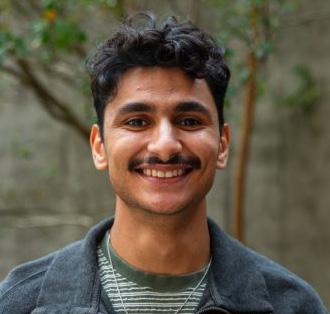
MOHAMMAD
TANTAWI Columnist
all Greek Life. But we don’t foresee that being the solution, as it erases the importance of cultural space and representation for Black students who are also in Greek Life.
It’s a shame that LSU disregarded the Greek Life organizations that use Unity Field. That disregard would not be the same if the shootings had originated on the Parade Ground.
In addition to the shootings, LSU Board of Supervisors Chair Scott Ballard said he doesn’t want kids walking through clouds of marijuana or hearing explicit music, which happens at all tailgates.
That sounds logical and practical, except when you remember that LSU football games are highlighted by the moment when everyone says, “Suck that tiger d*ck, b*tch.”
As for the marijuana smoke, though recreational weed isn’t currently legal in Louisiana, we need to grow as a society and acknowledge it as an alcohol equivalent. The drug is already legalized in 24 states for recreational use.
Crack open all the cans of beer you want in Louisiana, but God forbid someone lights a joint. It’s redundant and restrictive. Besides, most kids don’t know marijuana
smoke from skunk spray.
This is another example of collective punishment on a campuswide scale. Because some kids decided to bring weed — which tons of tailgates do — and another decided to involve himself in a shooting, we must now punish the Divine Nine chapters. It’s absurd and rooted in racism.
This is a classic example of punishing those who look nothing like you, whilst letting those who do, get away with the same things. Interim President Matt Lee and Ballard need to reflect on their motivations, because when someone says, “This is not about race,” it usually is.
Now, we don’t think the blending of Parade Ground is going to be exactly the “Kumbaya” some optimists may hope for. However, we do think that if LSU continues on this path, it will deepen the racial divide among its students. It’s blatant racism that once again, a marginalized group of students — specifically Black students — is getting the brunt of. Why is that? Because white people need to blame someone.
The crime on campus during game day had no affiliation with LSU students or the Unity Field tailgating area, but for some reason, LSU has decided to close Unity Field indefinitely.
As much as we would love to see a blend of our student body and see Divine Nine fraternities and so -
rorities congregate on the Parade Ground, a commonly proposed solution, but sadly, our university is moving backwards, just like our country.
Students are feeling the effects of this ruling and in our country at large.
“The state the world is in right now and what LSU has been doing recently is all adding up, making me feel like — ‘Do I even feel safe being here anymore?’,” Treazure Jackson, a junior studying theatre at LSU, said.
We’ve both been to the Parade Ground and Unity Field. Without a doubt, the community and atmosphere are different. Unity Field holds such a unique sense of diversity, culture and representation for our Black student body — representation that many students feel is missing elsewhere on campus. The decision to shut down Unity Field reinforces the idea that LSU has no issue with suppressing and blaming its marginalized student body.
Some students feel this discrimination isn’t just witnessed on the grounds of Unity Field.
“There’s nothing that happens at Unity Field that doesn’t take place anywhere else: underage drinking, smoking, explicit music — all of that stuff is seen all throughout places of the student body,” Christian Claiborne, a political science junior, said.
It shows students that even if you prefer a certain genre of mu-
sic, drink or do anything, on top of being Black, your chances of being scrutinized for it are higher.
Closing Unity Field takes away a safe and cultural space for Black students. It sends the message that LSU knows the school is a primarily white institution and that’s all they will represent.
“It’s a direct overreaction against, honestly, the Black community,” Allison DePriest, a senior at LSU studying theatre, said.
DePriest is right. The decision to close Unity Field is LSU’s way of playing into the harmful stereotype that Black people can’t have fun without bringing violence.
We hope the outrage following Unity Field’s closure inspires LSU’s minority students and Black Greek Life to stand even stronger together — showing the majority and the in-power that no matter how targeted their actions may be, they will never succeed in erasing Black presence or Black culture at our institution.
Though tailgating will continue in another location, what’s most important is that we ensure that we will no longer see incidents like the closure of Unity Field by holding conversations and using our voices to call out racism when we see it.
Blair Bernard is a 21-year-old theatre major from Lafayette, La., and Mohammad Tantawi is a 25-yearold mass communication senior from Smyrna, Tenn.
The AWS outage shows the failure of internet monopolies
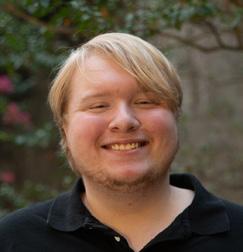
GORDON
On Monday, Oct. 20 I got a notification that my science exam had been posted to Moodle. I went to check and nothing. Quickly, to my horror, I realized that my bank account, Slack, Workday, Steam — almost every service I use regularly was blank.
That horror quickly turned to rage.
Sure, everything was back online at the end of the day. However, what if I was desperately stuck with no way to know if I had enough money for gas? What if I needed to urgently communicate something with my employer?
EDITORIAL BOARD
Jason Willis Editor in Chief
Olivia Tomlinson
Managing Editor
Courtney Bell News Editor
Chloe Richmond
Sports Editor
Garrett McEntee Opinion Editor
There’s no good reason that so much of the internet should solely rely on a few corporations’ services to complete basic functions. However, this is the new system we’ve found ourselves embroiled in. I’m sick of it.
I still fondly recall the last vestiges of the decentralized internet I was able to experience as a child. I remember writing down my passwords on paper, surfing across dozens of disconnected forums, browsing the niche self-hosted wikis and blogs for the games I was interested in. At some point, the internet experience transitioned from these little self-contained worlds, hosted by either individuals or companies dedicated to that service, to much larger, consolidated services, most of which are heavily reliant on a few megacorporate services.
The innovation of cloud com-
puting marked one of the biggest shifts in this paradigm. Instead of hosting a website on a specific, local server, the website can instead connect to a remote server hosting service over the internet.
This isn’t necessarily a bad thing. Cloud computing requires minimal upfront costs, is scalable based on fluctuating traffic, and allows for data to be altered from anywhere. However, the immense resource requirements to sustain a cloud computing business of great scale has led to the market being gradually consolidated by three familiar tech giants: Amazon, Microsoft and Google.
Thus, most of the internet finds itself entirely at the whim of a few West Coast conglomerates.
Any hit to their servers — even if just for a few hours — and the consequences are potentially dev-
astating.
This outage has exposed the desperate need for backup infrastructure, especially in the professional world. Companies and institutions managing hundreds of millions of dollars aren’t just surrendering control of their own data; they are practically giving up the right to even access it, simply to save some cash.
Organizations that can afford it must consider investing in maintaining some sort of traditional computing infrastructure. Take LSU, which primarily relies on a handful of services like Moodle and Workday, most of which use cloud computing services like Amazon Web Services, to manage its data. Thus, the outage not only resulted in students being unable to access their data, but even employees as well.
Editorial Policies and Procedures
The Reveille (USPS 145-800) is written, edited and produced solely by students of Louisiana State University. The Reveille is an independent entity of the Office of Student Media within the Manship School of Mass Communication. Signed opinions are those of the author and do not necessarily represent the views of the editor, The Reveille or the university. Letters submitted for publication should be sent via e-mail to editor@lsu.edu or delivered to B-39 Hodges Hall. They must be 400 words or less. Letters must provide a contact phone number for verification purposes, which will not be printed. The Reveille reserves the right to edit letters and guest columns for space consideration while preserving the original intent. The Reveille also reserves the right to reject any letter without notification of the author. Writers must include their full names and phone numbers. The Reveille’s editor in chief, hired every semester by the LSU Student Media Board, has final authority on all editorial decisions.
The economic consequences of an outage like this are the most tangible reason large institutions should adopt a hybrid cloud model. The exact amount of lost revenue and lowered productivity is hard to calculate, but when considering the sheer amount of money Amazon, Office, Chime, Lyft or any number of the other high value groups affected by the outage generate, it’s easily in the billions of dollars. So, institutions, including LSU, should seriously consider investing in on-premises hardware for some aspects of their data management. The upfront costs may be high, but when you consider the potential losses, that figure becomes a lot more appealing.
Gordon Crawford is a 19-yearold political science major from Gonzales, La.
